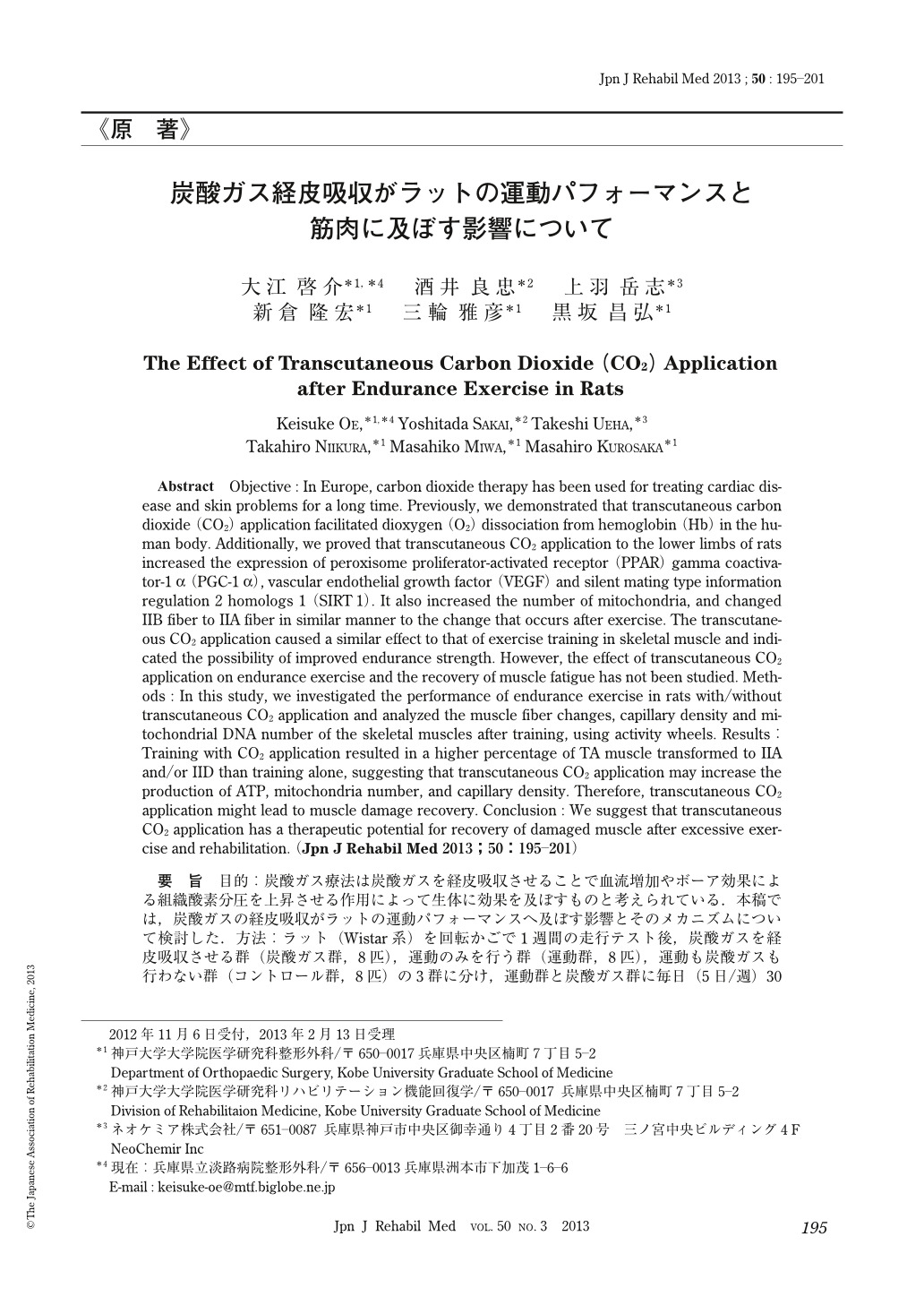Japanese
English
- 販売していません
- Abstract 文献概要
- 1ページ目 Look Inside
- 参考文献 Reference
要旨 目的:炭酸ガス療法は炭酸ガスを経皮吸収させることで血流増加やボーア効果による組織酸素分圧を上昇させる作用によって生体に効果を及ぼすものと考えられている.本稿では,炭酸ガスの経皮吸収がラットの運動パフォーマンスへ及ぼす影響とそのメカニズムについて検討した.方法:ラット(Wistar系)を回転かごで1週間の走行テスト後,炭酸ガスを経皮吸収させる群(炭酸ガス群,8匹),運動のみを行う群(運動群,8匹),運動も炭酸ガスも行わない群(コントロール群,8匹)の3群に分け,運動群と炭酸ガス群に毎日(5日/週)30分間の運動を4週間実施した後で,すべての群の前脛骨筋を摘出し組織学的・生化学的に筋線維を解析した.結果:炭酸ガス群でコントロール群と比べて有意に運動パフォーマンスが向上した.また,筋線維の解析では炭酸ガス群でⅡB線維からⅡD線維,ⅡA線維への移行やミトコンドリア数および血管密度の増加を認めた.結論:炭酸ガス経皮吸収はリハビリテーション後やスポーツ後の疲労回復効果などの臨床においても応用が期待される.
Abstract Objective : In Europe, carbon dioxide therapy has been used for treating cardiac disease and skin problems for a long time. Previously, we demonstrated that transcutaneous carbon dioxide (CO2) application facilitated dioxygen (O2) dissociation from hemoglobin (Hb) in the human body. Additionally, we proved that transcutaneous CO2 application to the lower limbs of rats increased the expression of peroxisome proliferator-activated receptor (PPAR) gamma coactivator-1a (PGC-1α), vascular endothelial growth factor (VEGF) and silent mating type information regulation 2 homologs 1 (SIRT1). It also increased the number of mitochondria, and changed ⅡB fiber to ⅡA fiber in similar manner to the change that occurs after exercise. The transcutaneous CO2 application caused a similar effect to that of exercise training in skeletal muscle and indicated the possibility of improved endurance strength. However, the effect of transcutaneous CO2 application on endurance exercise and the recovery of muscle fatigue has not been studied. Methods : In this study, we investigated the performance of endurance exercise in rats with/without transcutaneous CO2 application and analyzed the muscle fiber changes, capillary density and mitochondrial DNA number of the skeletal muscles after training, using activity wheels. Results : Training with CO2 application resulted in a higher percentage of TA muscle transformed to ⅡA and/or ⅡD than training alone, suggesting that transcutaneous CO2 application may increase the production of ATP, mitochondria number, and capillary density. Therefore, transcutaneous CO2 application might lead to muscle damage recovery. Conclusion : We suggest that transcutaneous CO2 application has a therapeutic potential for recovery of damaged muscle after excessive exercise and rehabilitation.

Copyright © 2013, The Japanese Association of Rehabilitation Medicine. All rights reserved.


